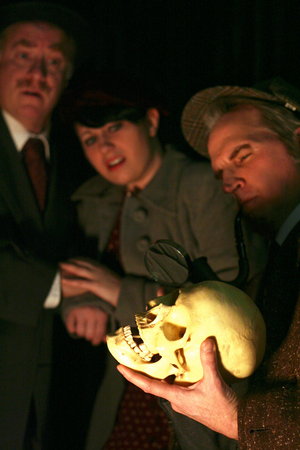Ann Arbor Civic Theatre lets loose the "Hound of the Baskervilles"

Jon Elliott, Danielle Nicholls, and Tom Underwood star in A2CT's production of "The Hound of the Baskervilles."
Photo by Tom Steppe
Tim Kelly’s stage adaptation of Sir Arthur Conan Doyle’s beloved mystery novel “The Hound of the Baskervilles” — being staged by Ann Arbor Civic Theatre — was written in 1976, and Kelly deliberately removed Victorian references and visual markers in order to update the tale.
“But I couldn’t see the characters, Holmes and Watson, in leisure suits,” said director David Andrews.
I know, I know. I think that might’ve been fun for a few minutes, too. But Andrews has instead moved the story to the 1930s, between the time when the story was first published (1901 in serial form, 1902 in book form) and Kelly’s own era.
“I’m taking a cue from the (Basil Rathbone and Nigel Bruce) films, … where they updated Holmes and Watson into a contemporary period at that time — partly so Holmes could fight the Nazis on film and boost the morale on the home front, and also, so that they could continue to churn out the films,” said Andrews. “Because not having to maintain the Victorian sets and costumes allowed them to do it in a way that was affordable, so they could produce quite a number of movies, and they were quite popular.”
The time setting will also free Andrews and his cast from getting bogged down in Victorian period items, like bustles and gaslight, so they can instead focus on telling the story of a man, Sir Henry Baskerville, who’s mortally threatened by an ancient family curse. Sherlock Holmes and his partner, Dr. Watson, venture out to the moor to find out more about the case, which involves a giant, supernatural hound that may have already killed Henry’s uncle.
PREVIEW |
“The design elements and technical elements, which sometimes take 2nd place when you have compelling characters like Holmes and Watson, … those will be very important in this show,” said Andrews.
Andrews first read “Hound” as a teenager, and later sought out both the Rathbone/Bruce films and radio plays (so Baker Street Irregulars should find comfort that a fan is at the helm of this “Hound”). Yet he deliberately avoided the recent hit film, “Sherlock Holmes,” starring Robert Downey Jr. and Jude Law.
“I didn’t want either to be subconsciously influenced to imitate it if it was a hit — which, of course, it turned out to be — or subconsciously influenced to run away from it if it turned out to be a huge flop,” said Andrews.
But it’s always tricky, of course, to present an iconic figure like Sherlock Holmes on stage. Everybody seeing the show has a highly defined sense of the character before they even walk through the door. So as a director, how do you balance an obligation to the audience’s expectations with freedom for the actors to find their own persona?
“I think as long as you’re giving the words the proper weight and the proper treatment, I think the words will carry you,” Andrews said. “The actors have gotten off-book in this show faster than any show I can remember, because I think they’re very excited to be a part of these characters and to speak these words — some of which, of course, people will recognize off the bat.”
And even audience members who know the novel version of “Hound” well may find themselves surprised. According to Andrews, “What they think they’re sure of, as far as the way plot turns out, may not be quite what they remember.”
Jenn McKee is the entertainment digital journalist for AnnArbor.com. Reach her at jennmckee@annarbor.com or 734-623-2546, and follow her on Twitter @jennmckee.


Comments
DEA
Sat, Mar 6, 2010 : 1:12 p.m.
Very nice preview. Thank you. One clarification: in the cause of 'credit where credit is due,' most of the consolidation of action in the play is thanks to Mr. Kelly, whose script eliminates many potentially problematic set changes.